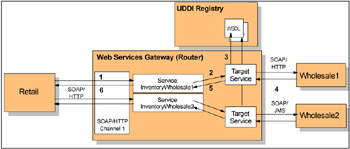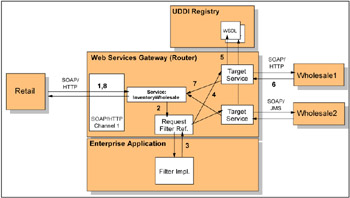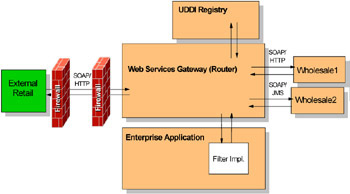8.5 System design overview
|
| < Day Day Up > |
|
8.5 System design overview
After considering the design guidelines, ABC Electronics decided to implement and test the solution in the following three stages.
8.5.1 Stage 1: Basic integration
In the first stage, the Retail and Wholesale departments are all internal to ABC Electronics. The Retail system is aware of which Wholesale department is supplying each part and codes the request appropriately. The Router provides transport protocol conversion and simple logging. It also provides a layer of abstraction between the systems that allows the Wholesale services to change or move without affecting the Retail systems.
The solution using WebSphere Web Services Gateway in this stage is shown in Figure 8-10.

Figure 8-10: Web Services Gateway implementation, stage 1
-
The client application (Retail) connects to the gateway using SOAP/HTTP to send the request to the channel.
-
The service within the gateway receives the request and resends it to the target service. In this phase, we are using one target service for each Web service defined
-
The location of the service provider (for example, Wholesale1) is obtained from the WSDL associated with the service. The location of the WSDL can be specified in two ways:
-
A URL that points to the WSDL file
-
A UDDI location
This example uses a UDDI registry.
-
-
The request from the client is redirected to the service provider (for example, Wholesale1).
-
The response is received by the gateway service.
-
The response is sent through the channel to the client.
8.5.2 Stage 2: Enhanced integration
In stage 2, a filter is added to the Router to determine the appropriate service needed to fill the request. The Retail system no longer needs to know which Wholesale supplier provides the part.
The solution using WebSphere Web Services Gateway in this stage is shown in Figure 8-11.

Figure 8-11: Web Services Gateway implementation, stage 2
-
The client application (Retail) connects to the gateway using SOAP/HTTP to send the request.
-
The service invoked by the client (for example, InventoryWholesale) receives the request and resends it to the request filter associated with it. The filter is actually an EJB in an enterprise application.
-
The component that implements the filter receives the request. In this example, the filter looks at the content of the message and selects the target service to be invoked.
-
The request sent by the client is sent to the target service specified by the filter.
-
The location of the service provider (for example, Wholesale1) is obtained from the WSDL associated with the service.
-
The request from the client is redirected to the service provider (for example, Wholesale1).
-
The response is received by the gateway service.
-
The response is sent through the channel to the client.
| Note | The addition of the filter means that the WebSphere Application Server Enterprise edition is required. |
8.5.3 Stage 3: Extended enterprise
The last stage is to make the Wholesale services available to external Retail systems.

Figure 8-12: Web Services Gateway implementation, stage 3
Stage 3 builds on stage 2 by externalizing the Wholesale services. The considerations are primarily security concerns. The interaction between the Retail, Wholesale, and Web Services Gateway remain the same as in stage 2.
|
| < Day Day Up > |
|
EAN: N/A
Pages: 102
- Step 1.1 Install OpenSSH to Replace the Remote Access Protocols with Encrypted Versions
- Step 2.1 Use the OpenSSH Tool Suite to Replace Clear-Text Programs
- Step 5.1 General Troubleshooting
- Step 5.2 Troubleshooting Common OpenSSH Errors/Problems
- Step 6.2 Using Port Forwarding Within PuTTY to Read Your E-mail Securely